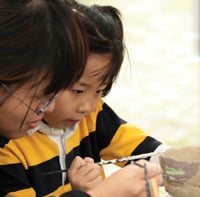If you treasure it, measure it?
The wellbeing agenda is developing alongside a demand for evidence-based practice. Daniel Callcut explores what this means for arts organisations

There has been a flurry of policy interest in the topic of wellbeing. The wider public, to the extent that it is familiar with the policy developments, probably associates this with the current Government, and with David Cameron’s numerous statements to the effect that we should focus not just on GDP (gross domestic product) but on GWB (‘general wellbeing’). But the critique of GDP as a measure of wellbeing has a long history. And other governments (France and Brazil, for example) have taken measures to acknowledge the fact that, as it is sometimes put, wealth does not equal wellbeing.
The policy developments are of obvious interest to arts organisations, especially those which focus on the connection between the arts and wellbeing. There is the question, often debated, of whether artists should in any way conceive of their work as aiming to further human wellbeing. This is sometimes rejected in the name of artistic autonomy, and at times seen as tantamount to a recipe for philistinism (or worse). But for arts organisations which are committed to a belief in the positive connection between the arts and human wellbeing – and advocate the benefits of participation in the arts, for example – the question of the relationship between the arts and wellbeing is an important one.
The so-called wellbeing agenda, at least at the policy level, has been developed in a way that dovetails with another familiar trend in public policy: the demand for evidence-based practice. The demand for evidence-based practice, at least on the surface, is unobjectionable – who wishes to support projects if there is no evidence that they work? But in practice the term ‘evidence-based’ has become something of a bugbear: people working in arts and health organisations (as in numerous other fields) fear that the demand for evidence-based practice will be implemented in a reductive way, and that what counts as ‘evidence’ will be construed in an excessively narrow fashion. Think about this in terms of grant applications. Will a large body of qualitative data (“this course was an enormous benefit because…”) count as evidence towards a funding bid? The concern is that narrative responses that do not assign numerical weightings to various fixed questions will be ignored. By contrast, will funding bids which provide positive numerical data achieve success in an almost knee-jerk fashion, even if the evaluations to which the numerals are assigned (on closer inspection) do not make much sense? Artists and scientists can unite in their opposition to pseudo-science.
The concern about reductionism and pseudo-science is compatible with an interest in solid quantitative data, and the various kinds of comparison facilitated by having such data. But, in order to collect quantitative data, we need to know what is being measured, and whether what is being measured is indeed measurable. What, after all, is wellbeing, and can it be measured? Is wellbeing the same as happiness, or welfare? Does wellbeing consist in how one feels, or how one judges one’s life to be going, or does the flourishing life (as many ancient philosophers held) consist in more than how one feels or judges but also in how one actually lives? Wellbeing researchers tend to focus on how people assess their own happiness, and the term generally used in the research literature for what is being measured is subjective wellbeing (SWB). But, as a measure of wellbeing, SWB is far from uncontentious (is the population in Brave New World flourishing if it has a high level of SWB?), and, even as a technical measure of a subjective state, SWB advocates disagree on whether the focus should be on a person’s reported feelings or on a person’s reported judgements (psychological criteria for wellbeing that are not always in sync). So, the budding science of wellbeing faces major challenges: can researchers agree on a stable and defensible definition of wellbeing, one which can be measured and will allow social-scientific study and comparison?
These philosophical and practical questions affect any research on wellbeing, whether that research concerns the effect of an anti-depressant or the effects of a 12-week pottery class. But the emphasis on evidence-based practice means that there are now far greater funding pressures than ever before on arts and health organisations to evidence the outcomes of their activities in scientific form. Defenders of SWB argue that, although no guarantee of wellbeing, it must surely be part of it: the happy life had better at least seem happy from the inside. And the evidence that we have (from a variety of different studies) suggests that engagement with the arts is a powerful and sustaining source of feeling good. Art, in other words, works.
Join the Discussion
You must be logged in to post a comment.